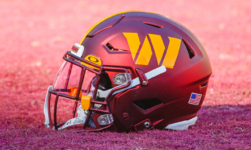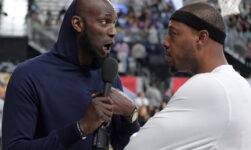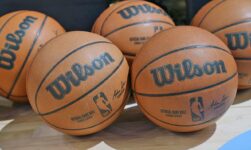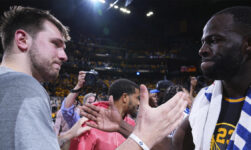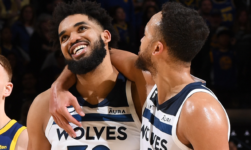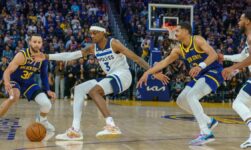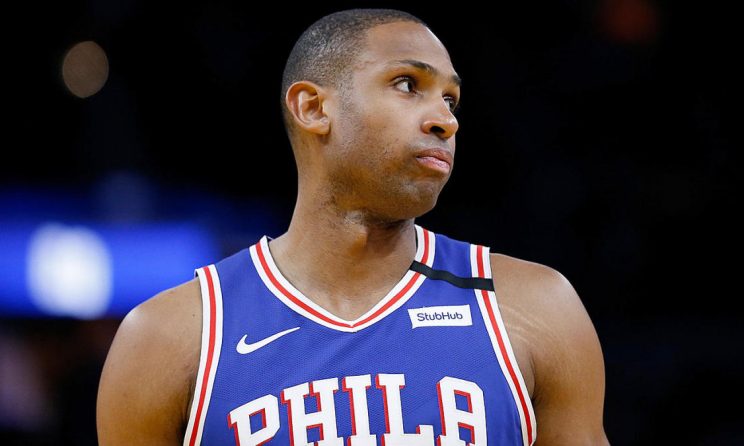
Over the past week your phone has likely been blowing up with alerts announcing the next big NBA move, and it’s honestly all a bit overwhelming. What’s big news one minute gets pushed aside when something fresh comes in, making it hard to keep track of all the moves that happened — let alone assess their significance.
Now that the dust has settled on the flurry of offseason moves with the draft and free agency in such close proximity due to the abbreviated calendar, we went through each NBA team and highlighted an important move that may not have gotten the attention it deserved due to the frenzied news cycle. Keep these in mind as you’re assessing your team’s offseason, since sometimes the most unheralded moves end up making all the difference.
Atlanta Hawks
The Hawks’ splashy offseason signings of Danilo Gallinari, Bogdan Bogdanovic and Rajon Rondo clearly indicate an intent to make the playoffs sooner rather than later, but let’s not forget that the core of this group is extremely young. Trae Young, John Collins, De’Andre Hunter, Kevin Huerter and Cam Reddish are all 23 and under, so drafting Okongwu — who could turn out to be the best big man in the draft class given his defensive versatility and offensive upside — adds to the future’s brightness while they try to win in the present. Clint Capela will likely have moved on by the time Atlanta is actually ready to compete for a title, so Okongwu can slot in perfectly as the defensive anchor and big man of the future.
Boston Celtics
Gordon Hayward’s exit and Jayson Tatum’s extension got most of the headlines, but Thompson was a huge addition for Boston. An NBA champion coming off a career season at age 29, Thompson had no shortage of suitors looking to add a defender and elite offensive rebounder to their rotation. The Celtics essentially replaced Enes Kanter with Thompson, which gives them about the same amount of offensive rebounding but much more switchability on defense. Thompson doesn’t do much in terms of halfcourt offense, but he did shoot 9 of 23 from 3-point range last season, which could be a nice added bonus.
Brooklyn Nets
The Nets declined their $5 million option on Garrett Temple, which left a vacancy for a defense-minded combo guard to go alongside the offense-heavy trio of Kevin Durant, Kyrie Irving and Joe Harris. The 24-year-old Brown, whom Brooklyn acquired in a three-team deal with the Clippers and Pistons, is set to earn just over $1.6 million this season, and provides many of the things that Temple did — perimeter defense, playmaking ability, solid 3-point shooting — in a much younger package. According to Synergy Sports Technology, Brown was in the 78th percentile, allowing 0.864 points per possession as a primary defender last season on a Pistons team that offered poor defensive parts around him. He was also more effective than Temple in catch-and-shoot situations. Re-signing Harris and acquiring sharpshooter Landry Shamet may be more noteworthy, but don’t underestimate the impact Brown will have on a Nets team with championship hopes.
Charlotte Hornets
LaMelo Ball is heading to town and the Hornets threw ungodly amounts of cash at Gordon Hayward, but drafting Riller in the second round was a strong, under-the-radar move. Some viewed the four-year College of Charleston star as a first-round talent, and Charlotte was able to snag him at No. 52. He was incredibly efficient in college, shooting 52 percent for his career as a 6-foot-3 combo guard, while hitting 36 percent of his 3-pointers.
He needs to work on playmaking, but he should be able to score and operate in the pick-and-roll from Day 1 off the Hornets bench, with potential to be an important piece down the road.
Chicago Bulls
The major headlines for Chicago’s offseason come from finally revamping the front office and replacing Jim Boylen with Billy Donovan, which makes most of the Bulls’ personnel moves secondary. But don’t overlook the Vonleh signing as the new regime attempts to figure out what they have. Playing Lauri Markkanen at center has proven to be a disaster defensively — the lineup of Markkanen, Zach LaVine, Tomas Satoransky, Thaddeus Young and Kris Dunn allowed 117.9 points per 100 possessions in 42 minutes last season. So Vonleh gives them a solid defensive big who can fill in when Wendell Carter Jr. is resting or injured. The Timberwolves’ defensive rating dropped from 110.6 to 102.1 with Vonleh on the court last season, granted in a small sample size.
Cleveland Cavaliers
Removing protections on Bucks’ future draft pick
The Cavs didn’t make any big signings this offseason, but they became a dumping ground for the unwanted contracts of JaVale McGee and Rayjon Tucker, which earned them second-round picks for their troubles. The most nerdily shrewd move they made, however, was to work with the Milwaukee Bucks to remove the protections on a future draft pick owed to the Cavs from a 2018 trade. Due to certain rules we don’t need to get into, the Bucks had to get rid of the protections on that pick in order to complete the Jrue Holiday trade. The Cavs obliged, which means they now receive an unprotected 2022 first-round pick from the Bucks. Why is that important, you ask? Let’s just say Giannis Antetokounmpo decides to leave Milwaukee next summer in free agency. That means the Bucks’ 2022 first-round pick could suddenly become a premier asset, and it now belongs to Cleveland. For their cooperation, the Cavs also received — you guessed it — a future second-round pick from the Bucks. They may not be exciting, but little moves like this can make all the difference for a rebuilding franchise.
Dallas Mavericks
As you might expect, the Mavericks offense was significantly worse with Luka Doncic on the bench last season. Bringing back Burke, who played 14 games with Dallas in the bubble including the playoffs, for his third stint with the franchise will help provide scoring and playmaking off the bench. He can also replace some of the shooting Dallas lost by swapping Seth Curry for Josh Richardson. Burke played over 29 minutes in each of the Mavericks’ final three playoff games, so clearly he’s earned Rick Carlisle’s trust.
Denver Nuggets
The Nuggets have been wise in recent drafts by finding hidden gems (Nikola Jokic, Jusuf Nurkic, Monte Morris) and taking top talent that has fallen for one reason or another (Michael Porter Jr., Bol Bol). They may have pulled it off again with Hampton, a 6-5 guard who was a top-five player in his high school class before a rough season in the Australian NBL caused him to plummet down draft boards. Hampton has the potential to be an elite NBA scorer, and the Nuggets have proven they have the patience and coaching to develop him over the next few years.
Detroit Pistons
The Pistons had, shall we say, an eventful offseason. Ignoring the extremely center-heavy roster construction and the $60 million they gave Jerami Grant, the Pistons took a low-risk flier on Jackson, a former No. 4 overall pick whom the Suns chose to give away when things never coalesced. Jackson, who grew up in the Detroit area, actually played pretty well in 22 games with Memphis to end last season, averaging 18.7 points, 6.2 rebounds, 3.3 assists and 1.7 steals per 36 minutes in a bench role. He probably won’t be a reliable 3-point shooter any time soon, but Jackson has a tendency to wreak havoc on the court in both good and bad ways. If he can find his role as an energy wing who can get out in transition and play defense, he could be a real asset for the Pistons at a very low price.
Golden State Warriors
After Klay Thompson’s injury, the Warriors have actually put themselves in pretty good shape to compete in the West, all things considered. Drafting James Wiseman and trading for Kelly Oubre Jr. are the more high-profile moves, but they bolstered their bench and wing depth by adding Bazemore on a team-friendly, minimum deal. This is a guy who made over $17 million per season over the last four years, and who will now provide much-needed defense and shooting for the Warriors. Bazemore never found his footing with the Blazers last season, but looked good in 25 games for the Kings to finish out the season, averaging 10.3 points on 38 percent 3-point shooting in 23 minutes per game. He’ll now return to the Warriors, who gave him his NBA start.
Houston Rockets
We have no clue what the Rockets’ roster will eventually look like with the uncertain futures of James Harden and Russell Westbrook, but the 25-year-old Brown is a piece who can fit alongside stars or be a part of a rebuild. The 6-5 wing was an important part of the 2018-19 Bucks’ success, but struggled to find consistent playing time last season partly due to improvement from Donte DiVincenzo and Pat Connaughton. Brown shot 36 percent from 3-point range two seasons ago in fewer than 18 minutes per game, and he could be ready to thrive if given a bigger role.
Indiana Pacers
A blue chip recruit who hadn’t yet figured things out when his lone season at Duke was interrupted, the 6-6, uber-athletic Stanley has all the makings of a player who exceeds his college production in a more open NBA style. He should absolutely crush in transition, and his shooting form suggests he’ll be able to duplicate, if not exceed, the 36 percent 3-point clip he made in college. Stanley was projected as a late first-round pick in mocks leading up to the draft, so for the Pacers to get him at No. 54 is a big win.
Los Angeles Clippers
Signing Serge Ibaka and Marcus Morris was huge for the Clippers, but exchanging Landry Shamet for Kennard could prove to be an important move. Not only is Kennard a promising young guard who can shoot 3-pointers (40 percent on 6.5 attempts per game last season) and create plays (4.1 assists), but he also provides some insurance should the Clippers end up moving Lou Williams. Kennard can help run the second unit when Kawhi Leonard and/or Paul George are on the bench, and will serve as a deadly spot-up threat for a team with championship aspirations.
Los Angeles Lakers
The Lakers made some big moves this offseason, but they couldn’t have executed their game plan without getting rid of Danny Green’s $15 million contract. They ended up trading him for Dennis Schroder, but he’s a much different player than Green. In order to approximate Green’s role, the Lakers were able to sign Matthews for the bi-annual exception of $3.6 million. Sure, the Lakers probably lose a bit defensively in the swap, but Matthews and Green had nearly identical statistics last season.
The Matthews signing gives the Lakers incredible lineup versatility, and fills most of Green’s role at a fraction of the cost.
Memphis Grizzlies
Trading up to draft Desmond Bane
You can’t get more than 30 seconds into Bane’s scouting video without falling in love, and the Grizzlies pounced on the opportunity to trade up to draft him with the last pick of the first round. He’s a knock-down 3-point shooter in an Olympic weightlifter’s body who should space the floor wonderfully for Ja Morant, Jaren Jackson Jr. and Co.
At 22 years old, Bane should be able to compete for minutes right away in a Grizzlies wing rotation that suddenly looks pretty solid with Justise Winslow, Dillon Brooks and Kyle Anderson.
Miami Heat
The Heat brought back Goran Dragic and extended Bam Adebayo, but they lost Jae Crowder — a key component to last season’s Finals run — and Derrick Jones Jr. in free agency, leaving a shortage on the wing. Miami found a solid replacement in Harkless, whom they signed to a one-year, $3.6 million deal. Able to guard multiple positions, he fits right into the Heat’s switching defense and has been a capable — if inconsistent — 3-point shooter throughout his career. Last season with the Clippers, in a similar role he’ll probably play with the Heat, he produced a solid 1.1 points per possession in catch-and-shoot opportunities, per Synergy.
Milwaukee Bucks
We all know about the haul that the Bucks forked over for Jrue Holiday and the utter mess surrounding the botched Bogdan Bogdanovic sign-and-trade, but Milwaukee somewhat stealthily added to its depth this offseason with veteran pieces like DJ Augustin, Bryn Forbes and Bobby Portis. The one that stands out the most among the crew, however, is Craig, whom the Bucks were able to sign to a one-year, minimum deal. Every competitive team can always use a versatile wing defender, and the Bucks are no exception. Craig fills that role to a tee and is capable enough from 3-point range to at least hold his own. He’ll be a valuable weapon in Mike Budenholzer’s arsenal come playoff time.
Minnesota Timberwolves
If you want to change your culture, you need high-character, hard-working veterans. That’s exactly what the Wolves got when they traded Jacob Evans, Omari Spellman and a future second-rounder for Davis. He didn’t play much in Utah last season, but two years ago in Brooklyn, Davis averaged an absurd 17.3 rebounds (5.4 offensive) per 36 minutes as an energy big off the bench. He’s not a rim protector, but he is able to switch from the center position, giving the Wolves a different look than they have with Karl-Anthony Towns and Naz Reid.
New Orleans Pelicans
The Pelicans’ lively offseason included hiring Stan Van Gundy as head coach, extending Brandon Ingram, acquiring Steven Adams and collecting up to four more future first-round picks to add to their hoard in exchange for Jrue Holiday. All of this may obscure the fact that they drafted their potential point guard of the future (assuming they eventually part ways with Eric Bledsoe and/or Lonzo Ball) with the No. 13 pick in Kira Lewis Jr. A blazing quick 19-year-old who should thrive in transition, Lewis is a perfect complement to Zion Williamson in New Orleans’ up-tempo style. A solid 3-point shooter who can pull up or finish at the rim, Lewis should be fun to watch in pick-and-rolls with Williamson, Adams and Jaxson Hayes.
New York Knicks
Turning Ed Davis into three second-round picks
Knicks fans must be oddly refreshed by the lack of headlines for their team this offseason. The new front office, led by Leon Rose, has kept things simple with low-cost, short-term signings, and shrewdly acquired four second-round picks in three separate deals. Three of those came from Ed Davis alone. The Jazz gave New York two future second-rounders for taking him off their hands, then the Knicks re-routed him to Minnesota while picking up another future second-round pick along with Jacob Evans and Omari Spellman — two youngsters who may still develop into rotation players. Moves like this aren’t exactly flashy, but at this point asset collection is a wise strategy for the Knicks.
Oklahoma City Thunder
Creating a $27.5 million trade exception
You don’t often see teams sending out press releases with “generates trade exception” in the headline, but that’s totally on-brand for Sam Presti’s Thunder. By facilitating a sign-and-trade with the Hawks for Danilo Gallinari, OKC created a $27.5 million trade exception, the largest in NBA history for about five glorious days, until the Celtics generated a $28.5 million exception in the Gordon Hayward sign-and-trade. The exception expires in one year, and it gives the Thunder all sorts of options if they want to accelerate their rebuild after this offseason’s fire sale in which they parted ways with Gallinari, Chris Paul, Dennis Schroder and Steven Adams.
Orlando Magic
Signing Chuma Okeke to his rookie deal
Unless you’re a rabid Magic fan you probably forgot, but Orlando took an interesting approach with last summer’s No. 16 overall pick, Chuma Okeke. After tearing his ACL in the Sweet 16, Okeke elected not to sign his rookie deal and instead spent the extra year and change rehabbing before finally inking his rookie deal this offseason. The move was supposed to allow Okeke to make about $330,000 more, but because of the pandemic the rookie scale is actually the same as last season so he’ll earn the same salary. Still, the Magic will add a young, exciting prospect who some fans may not realize they had.
Phoenix Suns
Early last season, Suns coach Monty Williams was already noting how important Carter was to the team’s renewed defensive tenacity, and it continued throughout the season as Carter became an integral part of Phoenix’s emergence as a potential 2020-21 contender. Obviously the expectations went through the roof when the team acquired Chris Paul and signed Jae Crowder, but re-signing Carter to a three-year, $11.5 million deal was crucial. Not only is Carter a defensive bulldog, but he also shot 43 percent on 2.5 3-pointers per game last season. He was blistering in the bubble, making 16-of-29 3s during the Suns’ 8-0 performance. Carter has become confident in punishing teams that drop on him in the pick-and-roll, averaging 1.061 points per possession (88th percentile) on off-the-dribble jumpers, according to Synergy.
In addition to his defensive talents, Carter could take another leap forward this year on the offensive end.
Philadelphia 76ers
Shedding Al Horford’s contract
Based on last season’s performance, the three years and approximately $80 million left on Horford’s contract were looking like one of the league’s bigger albatrosses, but new president of basketball operations Daryl Morey wasted no time flexing his muscles by not only getting rid of Horford, but also picking up Danny Green and Terrance Ferguson in the process (no pun intended). While Green and Ferguson are nice additions, the real win for Morey is only giving up one first-round pick (2025, top-six protected) as payment to the Thunder for taking on Horford’s contract. With all the money already owed to Joel Embiid, Ben Simmons and Tobias Harris, this was a necessary move to open up flexibility for the Sixers moving forward.
Portland Trail Blazers
I already gushed about the Giles signing in our NBA free agency roundtable, so instead of trying to summarize my own words, I’ll just give you the quote:
The Blazers made some great moves this offseason, so the Harry Giles signing might fly a bit under the radar. Still just 22 years old, Giles is an energy big who has soft touch around the basket and averaged 17 points and 10 rebounds per 36 minutes last season in Sacramento. He was the No. 1 player in his high school class before multiple injuries derailed his trajectory, and there is a lot of offensive potential for Portland to develop. Giles also provides a nice contrast to Jusuf Nurkic, Zach Collins and Enes Kanter. He may not play a ton to start, but if injuries rear their ugly head he’s a great insurance policy.
Sacramento Kings
With all the money thrown at centers this offseason, it’s funny that a guy who averaged a double-double and led the league in blocks for a playoff team last season would end up signing for the minimum. Say what you will about Whiteside, but the man produces. To get that kind of value on a minimum deal is a win for the Kings, particularly given Marvin Bagley’s injury history during his young career. The Kings had a strong draft by picking up Tyrese Haliburton and Robert Woodard, but don’t let that overshadow the fact that they were able to get a quality big at a rock-bottom price.
San Antonio Spurs
You hear a lot about how lucky the Kings were to get Tyrese Haliburton at No. 12, but you don’t hear as much about Vassell going to the Spurs at No. 11. Vassell was the best 3-and-D prospect in the draft, and he goes to a culture known for maximizing talent. He should be able to contribute right away on both ends, and has offensive potential that puts him a cut above the other players in the draft with similar profiles. Don’t be surprised if in a few years we’re talking about how the Spurs hit another draft home run with Vassell.
Toronto Raptors
Toronto was left with a gaping hole in the middle when Serge Ibaka and Marc Gasol both went to L.A., and Baynes is just about as strong of a replacement as you could hope for. He’s a defensive monster who has become a bona fide stretch-five, making 35 percent of his four 3-point attempts per game last season with the Suns. Re-signing Fred VanVleet was the obvious offseason priority, but Baynes is just the type of smart, defensive-minded player who will fit in perfectly as the Raptors look to once again contend for an NBA title.
Utah Jazz
Locking up Donovan Mitchell and signing Jordan Clarkson to a robust four-year, $52 million contract may have overshadowed the Jazz bringing back Favors, an essential part of their elite defense before he was traded to New Orleans prior to last season. The Jazz went smaller last season and it cost them defensively, as they slipped to 13th in the league after finishing no lower than third in each of the previous three seasons. Favors gives coach Quin Snyder his options back, with the ability to go big with Favors next to Rudy Gobert, or to simply have Favors hold down the fort as an overqualified backup. Utah’s defensive rating was 3.7 points better when Favors was on the court in 2018-19, and he should have a similar impact in his return this season.
Washington Wizards
The Wizards gave all the money to Davis Bertans and drafted a good young prospect in Deni Avdija, but those two do little to improve the awful defense that lost Washington so many games last season. Enter Robin Lopez on a one-year, $7.3 million deal. The veteran big man isn’t afraid to voice his opinion in the locker room, and should bring a toughness and intensity to the Wizards defense that they severely lacked last season. He also shot 105 3-pointers last season, making 33 percent of them, so he may be more of a bonus on offense than expected.

